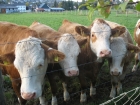What is new in Biotech
Sea sponge-inspired microlenses offer new possibilities in optics
18.12.2024 | Press monitoring
Beneath the ocean's surface, simple marine animals called sea sponges grow delicate glass skeletons that are as intricate as they are strong. These natural structures are made of a material called silica – also known as bioglass – that is both lightweight and incredibly durable, allowing the sea sponges to thrive in harsh marine...
Precision engineering enables design of virus-like particles that can deliver genetic material into cells
16.12.2024 | Press monitoring
Scientists from NPL, working in collaboration with AI experts from IBM and the Science and Technology facilities Council (STFC) Hartree Center, are applying the principles of precision engineering of biological systems to enable the design of artificial virus-like particles capable of encapsulating genes. Such particles, known as virions, can be...
Bacteria biofilter reduces pig farm methane emissions
13.12.2024 | Press monitoring
In the spring of 2024, Denmark housed almost 11.5 million pigs. Although many are exported, some are also consumed in Denmark. But our meatballs and roast pork leave a climate footprint because of the pig manure, which during storage in slurry tanks produces methane – an extremely potent greenhouse gas. This has created an opportunity to test...
Nanopore direct RNA sequencing finds cancer\'s fingerprint to improve early detection
11.12.2024 | Press monitoring
Different types of cancer have unique molecular "fingerprints" which are detectable in early stages of the disease and can be picked up with near-perfect accuracy by small, portable scanners in just a few hours, according to a study published today in the journal Molecular Cell. The discovery by researchers at the Centre for Genomic Regulation...
Implants made of your blood could repair broken bone
9.12.2024 | Press monitoring
The body has a remarkable ability to heal itself when injured, but of course it has its limits. Now scientists at the University of Nottingham have developed a way to improve on the natural process, making implants created from a patient’s own blood to regenerate injuries, even repairing bone. Bodily tissues can heal small cuts or fractures...
Nanorobot hand made of DNA grabs viruses for diagnostics and blocks cell entry
6.12.2024 | Press monitoring
A tiny, four-fingered hand folded from a single piece of DNA can pick up the virus that causes COVID-19 for highly sensitive rapid detection and can even block viral particles from entering cells to infect them, University of Illinois Urbana-Champaign researchers report. Dubbed the NanoGripper, the nanorobotic hand also could be programmed to...
Engineered enzymes may help plants adapt to higher temperatures
4.12.2024 | Press monitoring
As global temperatures rise, it's imperative that plants can adapt to new and changing conditions. Michigan State University researchers from the Walker lab are looking at ways to give plants an assist. More specifically, their research aims to help plants adapt to changing temperatures by introducing engineered enzymes that will increase...
Newly designed nanocrystals can kill bacteria under visible light
2.12.2024 | Press monitoring
Newly developed halide perovskite nanocrystals (HPNCs) show potential as antimicrobial agents that are stable, effective and easy to produce. After almost three years, Rice University scientist Yifan Zhu and colleagues have developed a new HPNC that is effective at killing bacteria in a biofluid under visible light without experiencing light- and...
Using a parasite pest to create bioluminescent wood
29.11.2024 | Press monitoring
In order to defy climate change and the bark beetle, more deciduous trees are being planted in Swiss forests. If possible, their wood should be used several times before it ends up as firewood, thus releasing the previously bound CO? back into the atmosphere. At present, however, hardwood is still too often used directly for heating. One...
Molecular morphers: DNA-powered gels shape-shift on command
27.11.2024 | Press monitoring
Johns Hopkins engineers have developed gel strips that change shape when given chemical instructions written in DNA code. These "gel automata," measuring just centimeters, can grow or shrink, transforming from one letter or number to another when triggered by specific DNA molecules. This breakthrough opens possibilities for shape-shifting...































